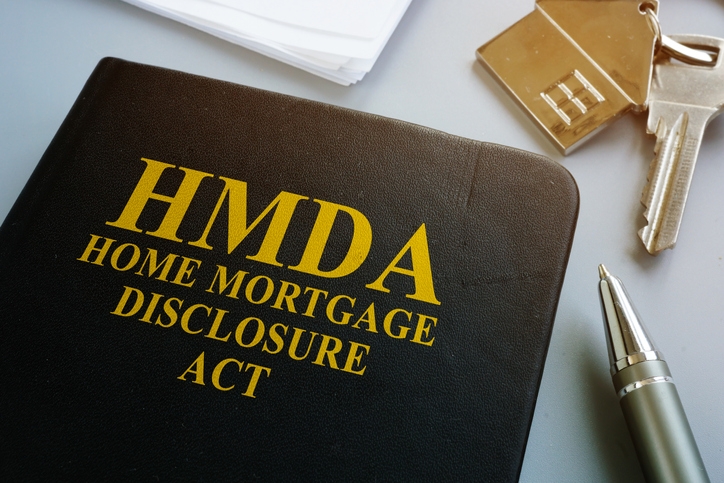Advertisement
HMDA Snags … Are You Getting Caught?

On Aug. 30, 2019, the Federal Financial Institutions Examination Council (FFIEC) announced the availability of aggregate data on mortgage lending transactions at 5,683 U.S. financial institutions (FIs) covered by the Home Mortgage Disclosure Act (HMDA), including banks, savings associations, credit unions and mortgage companies.
 The data covers 2018 lending activity submitted, or re-submitted, on or before Aug. 7, 2019. It includes 48 data points, providing information about the applicants, the property securing the loan or proposed to secure the loan in the case of non-originated applications, the transaction, and identifiers. Many of the data points are available for the first time as part of the new, expanded HMDA data set, and some points are presented based on ranges or rounding certain fields, such as age, debt-to-income (DTI) and loan amount.
The data covers 2018 lending activity submitted, or re-submitted, on or before Aug. 7, 2019. It includes 48 data points, providing information about the applicants, the property securing the loan or proposed to secure the loan in the case of non-originated applications, the transaction, and identifiers. Many of the data points are available for the first time as part of the new, expanded HMDA data set, and some points are presented based on ranges or rounding certain fields, such as age, debt-to-income (DTI) and loan amount.The release of the data was accompanied by several caveats. For example, per CFPB guidance, caution should be used when comparing HMDA data across multiple years due to changes in HMDA definitions, values, and thresholds. Also, caution is required for certain geographic areas due to the changes in Metropolitan Statistical Areas (MSAs) and census tract boundaries, and updates to the population and housing characteristics of census tracts, especially those that follow the decennial census and five-year updates based on the American Community Surveys (ACS) data.
Additional caveats cited by the Consumer Financial Protection Bureau (CFPB) remind users of the information that HMDA data alone cannot be used to determine whether a lender is complying with fair lending laws. The data does not include some legitimate credit risk considerations for loan approval and loan pricing decisions, and when regulators conduct fair lending examinations, they analyze additional information before reaching a determination about an institution’s compliance with fair lending laws.
The release of the data was also accompanied by initial observations about the Aug. 7, 2019 HMDA data set. In addition to varying degrees of analysis of the underlying data, it is possible that these observations and conclusions about the data might also be used by key stakeholders including regulators, state attorney generals, consumers, community action groups, and the general public.
Some will use this data in trying to assess how well financial institutions are meeting the needs of their communities under the provisions of the Community Reinvestment Act (CRA), as well as to detect any suggestions of unfair treatment on a prohibited basis under fair lending rules and regulations. Therefore, it is more important than ever that FIs heed the signs of potential treacherous waters ahead, understand what story their data are telling, and ensure their data integrity standards are sufficient to stay afloat in the event that storms rise up on the horizon.
Build strong vessels for rugged seas
The basis for sturdy shipbuilding in the context of data integrity is a robust HMDA Compliance Management System (CMS). A solid CMS starts with having a strong culture of compliance around HMDA policies, procedures and training across all channels, including retail, consumer and commercial; and extending to associated third parties where applicable. It is critical to ensure that all data that needs to be collected is being collected, and updated where appropriate, in a timely manner.
The 2018 expanded HMDA data include many fields of data that were not previously mandated for HMDA reporting. FIs should pay special attention to ensure all new fields are being collected across all appropriate lines of business, including new underwriting and pricing data critical for fair lending analytics. For example, new underwriting fields include information on income, the name and version of the credit scoring model, the automated underwriting system (“AUS”) name, combined loan-to-value (CLTV) and denial reason. New pricing fields include information on interest rate, total loan cost or points and fees, origination charges, discount points, lender credits and rate spread.
Preventive and detective controls should be implemented and aligned to key risks in support of accurate data collection and reporting and documented as part of a detailed HMDA Risk Assessment. Key stakeholders, executive management and the board of directors should receive regular and informative reports identifying any gaps or system issues that may be affecting the flow and integrity of data.
Cast nets to catch big fish
With the release of the public aggregate data, many FIs are anxious about conducting fair lending and CRA analytics on their 2018 data, but it is critical to first confirm that the data being used are accurate. It’s a good time to cast nets to catch any errors that are surfacing in the data, and then develop a risk-based approach to fine-tune the size of the net and drill down to find other errors that may be hiding in the weeds.
HMDA challenges are reflected in Wolters Kluwer’s annual Regulatory & Risk Management Indicator survey, where concern levels about managing HMDA obligations jumped significantly among reporters–from 21 percent in 2018 to 35 percent in 2019–particularly relating to their ability to analyze newly collected HMDA data. And concerns about reporting those expanded data to regulators increased significantly–from 15 percent in 2018 to 40 percent in 2019.
Following are some “Big Fish” areas to review to ensure that your FI understands these basic concepts as you re-visit your policies, procedures, and training; confirm specific guidance for source documentation for every field, for every line of business; and start your data integrity scrubs:
►The definition for “Dwelling”
►The potential relationships between codes (e.g. If Preapproval equals code 1 [Preapproval Requested], then Loan Purpose must equal code [Home Purchase])
►The distinction between blank fields, “NA” and codes (e.g. “8888”)
►The appropriate codes for Co-Applicant whenever an action is one that does not require a credit decision, such as withdrawn, closed incomplete or purchased
►When to report Total Loan Costs or Total Points and Fees
►Calculations, such as when to start calculating for Loan Term for a Line of Credit (from action date) v. Loan (from first payment)
►The appropriate codes for Counteroffers and Action Taken
►All rules for collecting Demographic Information, especially in a commercial context
►The appropriate codes for Co-Applicant whenever an action is one that does not require a credit decision, such as withdrawn, closed incomplete or purchased
►The distinction between blank fields, “NA” and codes (e.g. “8888”)
►The appropriate codes for Co-Applicant whenever an action is one that does not require a credit decision, such as withdrawn, closed incomplete or purchased
►When to report Total Loan Costs or Total Points and Fees
►Calculations, such as when to start calculating for Loan Term for a Line of Credit (from action date) v. Loan (from first payment)
►The appropriate codes for Counteroffers and Action Taken
►All rules for collecting Demographic Information, especially in a commercial context
►The appropriate codes for Co-Applicant whenever an action is one that does not require a credit decision, such as withdrawn, closed incomplete or purchased
Avoid running aground
Following is one area that is getting FIs stuck in the mud as they conduct HMDA data integrity reviews—how to report on Multifamily Affordable Housing Units.
Identifying Multifamily loans is not as easy as it once was. Prior to 2018, the property type field identified the property securing the loan as either a one-to-four family dwelling, a manufactured dwelling, or a multifamily dwelling.
Beginning with 2018, property type was eliminated and now there are multiple fields to complete, including Construction Method (Site Built, Manufactured Home), Manufactured Home Secured Property Type, Manufactured Home Land Property Interest, Total Units and Multifamily Affordable Units. The following focuses on some common pitfalls in these last two fields.
Total Units represents the number of units securing the loan. It could include multiple single-family dwellings, and it could include multiple, but not all, condos or co-ops in a building. Importantly, you cannot rely on Total Units to determine the number of Multifamily Affordable Housing Units.
To find the number of Multifamily Affordable Units, it’s best to approach this as a three-step analysis:
►Step one, proceed only if this is a “dwelling” containing five or more individual units.
►Step two, confirm that the loan is secured by the entire property. If not, the property is not considered Multifamily, and therefore enter “NA.”
►Step three, determine how many units are “affordable.” Enter “0” for a covered loan or application related to a multifamily dwelling that does not contain any such “affordable” income-restricted individual dwelling units. Please note the difference between when “NA” is used, and when “0” is used. A blank field will generate a validity edit. Also note that Multifamily property includes Manufactured Home Community.
The following are examples of different combinations of the Total Units and Multifamily Affordable Units fields:
►Step two, confirm that the loan is secured by the entire property. If not, the property is not considered Multifamily, and therefore enter “NA.”
►Step three, determine how many units are “affordable.” Enter “0” for a covered loan or application related to a multifamily dwelling that does not contain any such “affordable” income-restricted individual dwelling units. Please note the difference between when “NA” is used, and when “0” is used. A blank field will generate a validity edit. Also note that Multifamily property includes Manufactured Home Community.
The following are examples of different combinations of the Total Units and Multifamily Affordable Units fields:
►A borrower purchases seven individual condominium units out of a 164-unit complex. Seven “Total Units” would be reported, if each is securing the loan. Because the individual units do not represent a multifamily dwelling, the “Multifamily Affordable” field would be populated with “NA.”
►A borrower purchases an entire seven-unit complex with no affordable housing. While there are five or more units and the entire building is purchased, none of the dwellings in the seven-unit complex are affordable housing, therefore, Multifamily Affordable units would be populated with “zero.”
►A borrower purchases an entire 12-unit complex with three affordable housing units. Twelve Total Units and three multifamily affordable units would be reported.
►A borrower purchases an entire seven-unit complex with no affordable housing. While there are five or more units and the entire building is purchased, none of the dwellings in the seven-unit complex are affordable housing, therefore, Multifamily Affordable units would be populated with “zero.”
►A borrower purchases an entire 12-unit complex with three affordable housing units. Twelve Total Units and three multifamily affordable units would be reported.
Smooth sailing
These are just a few tips to help FIs with shoring up any data integrity leaks. Avoid any last-minute rescue efforts by conducting regular data integrity reviews and performing periodic checks against the current edit list provided by the CFPB. Having reliable data will help you set a course for smooth sailing as you use the data for CRA and fair lending analytics.
Ann-Marie Lefebvre is a consulting manager with the Wolters Kluwer U.S. Advisory Services team, with industry experience and strong understanding of HMDA and Community Reinvestment Act requirements to create customized training programs for banking customers. She can be reached by e-mail at [email protected].
About the author





